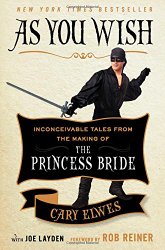
 As You Wish
As You WishInconceivable Tales from the Making of The Princess Bride
Review posted February 11, 2015.
A Touchstone Book, Simon & Schuster, 2014. 259 pages.
Starred Review
2015 Sonderbooks Stand-out: #4 Personal Stories
Reading this book was wonderful! Fans of The Princess Bride will love it! And if you’re not a fan of The Princess Bride? How on earth are you not? That very idea is inconceivable to me – and I know what the word means.
What’s in the book? Cary Elwes, who, of course, starred as Westley in the movie, tells stories about making the movie. The book is also peppered with reminiscences by the other actors and actresses. They do all work together to convince the reader that making that movie was almost as extraordinary an experience as the final film turned out to be extraordinary.
I loved it that Cary Elwes had read and loved William Goldman’s book The Princess Bride when he was thirteen years old. What are the chances?
A huge part of making The Princess Bride was the actors learning to swordfight. I have a completely new appreciation for the Greatest Swordfight in Modern Times.
“Don’t worry,” Rob insisted. “You’ll be training with the best. It’ll be fun!”
Training, with the best!
It always sounds fun in conversation. But the practical reality is something quite different. More like, “Don’t worry, you’ll be training with the best Sherpa to help you climb Everest!” or “Don’t worry, you’ll be training with the greatest human cannonball before we fire you out of the cannon.” I’d long admired serious athletes, and I always try to treat a challenge as an opportunity. And then I began to think, Wait a minute! How hard could it really be? I’d seen plenty of Errol Flynn and Douglas Fairbanks movies. My developing, inane theory was that if they could do it, so could I. It didn’t seem all that difficult. A few quick thrusts, some fancy footwork. More like dancing than combat.
I could handle it, I thought. No problem.
I was, of course, somewhat deluded….
And then we went to work. The first day was devoted to the most basic body mechanics, starting with the proper stance. Mastery wasn’t really the goal – there wasn’t enough time for that. Rather, it would have to be the illusion of mastery, and that could only be achieved by adhering to the fundamentals of fencing: how to stand, where to place your arms and feet. How to hold your free hand, not clenched but relaxed (something I had a hard time perfecting). A professional fencer, they explained, could watch a sword-fighting sequence on film and tell immediately if the actors involved were complete amateurs. The easiest to spot were when the actors or stuntmen could be seen just hitting the swords back and forth, over and over in the same manner, the way kids do with sticks.
They explained that they had requested that the fighting sequences be filmed late in the production, allowing us a few weeks of intense daily training in prep, followed by a few months of training while on location. Bob then pointed out that although it wasn’t possible for either of us to become an Olympic-caliber fencer in that amount of time, maybe with the help and guidance of both himself and Peter, we might just be capable of fooling all but the most discerning of viewers. Their reputations were at stake as well, after all, he pointed out.
Cary had nothing but praise for Robin Wright as Buttercup. He pointed out something I hadn’t noticed:
Buttercup falls in love, loses her love, gets kidnapped, is forced into an arranged marriage, reconnects with her one true love, and then lets him go in order to save his life. It really requires a great deal of emotional range. What it doesn’t require – or at least doesn’t display – is the comedic talent for which The Princess Bride is so well known. Goldman wrote a screenplay that we now know is filled with great, classic funny lines. Unfortunately, few, if any, of those lines are given to Buttercup. Robin is not merely the victim in the film; she is also the straight man (or, in this case, the straight woman). And even though Westley is not exactly a comedian, he does have some funny lines, and is involved in some rather broad physical comedy. Robin’s character is permitted no such relief. From start to finish, she had to play it straight, exactly as the role demanded.
Of course, I had to watch The Princess Bride again (for the I-have-no-idea-how-many-th time) after reading this book. I watched for evidence of Cary Elwes’ broken toe, and totally saw it. But mostly, the book just gave me added appreciation for a film I already love with all my heart.
This book celebrates a film that was done right, from start to finish.
